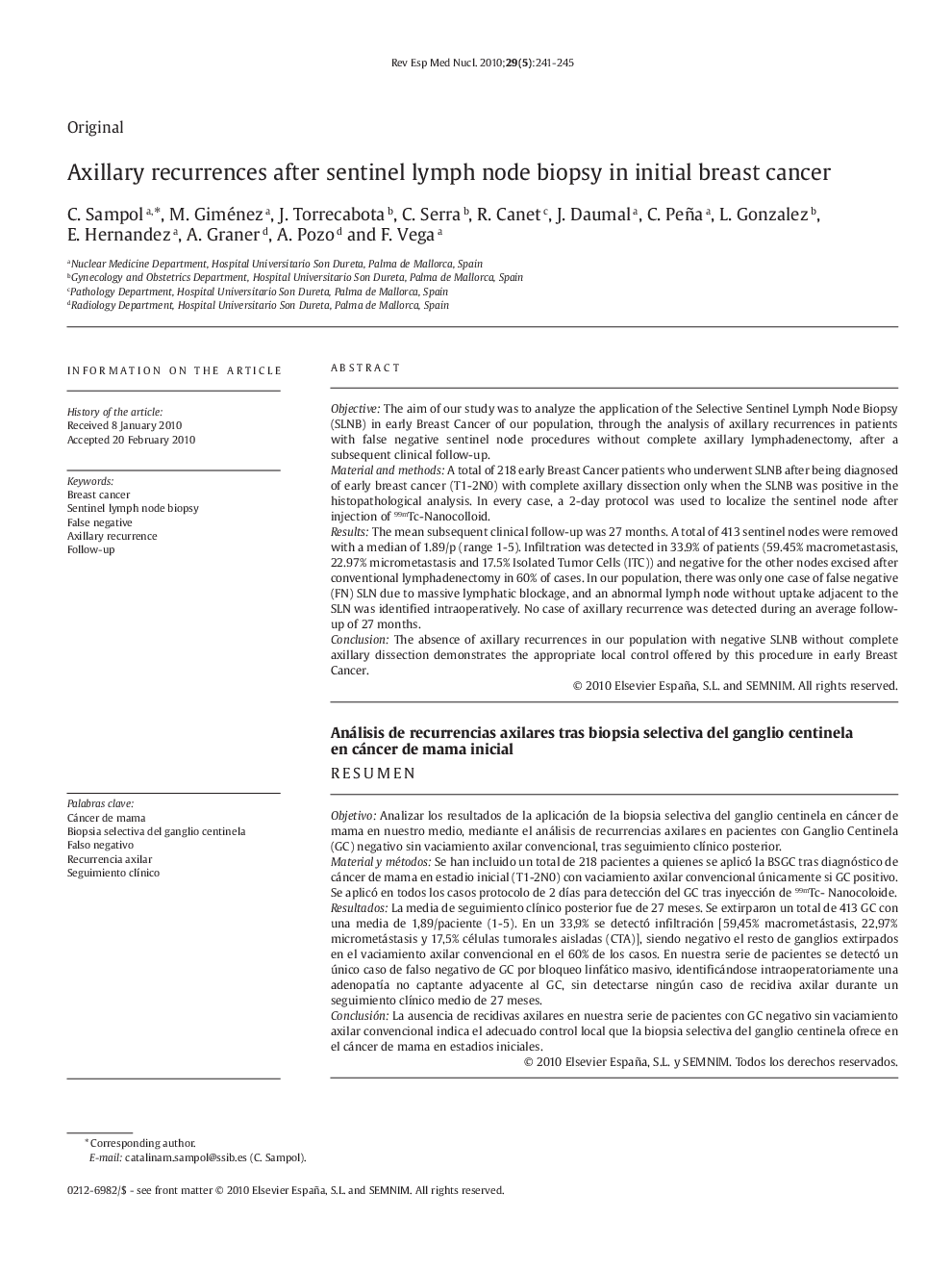| Article ID | Journal | Published Year | Pages | File Type |
|---|---|---|---|---|
| 4249512 | Revista Española de Medicina Nuclear (English Edition) | 2010 | 5 Pages |
ObjectiveThe aim of our study was to analyze the application of the Selective Sentinel Lymph Node Biopsy (SLNB) in early Breast Cancer of our population, through the analysis of axillary recurrences in patients with false negative sentinel node procedures without complete axillary lymphadenectomy, after a subsequent clinical follow-up.Material and methodsA total of 218 early Breast Cancer patients who underwent SLNB after being diagnosed of early breast cancer (T1-2N0) with complete axillary dissection only when the SLNB was positive in the histopathological analysis. In every case, a 2-day protocol was used to localize the sentinel node after injection of 99mTc-Nanocolloid.ResultsThe mean subsequent clinical follow-up was 27 months. A total of 413 sentinel nodes were removed with a median of 1.89/p (range 1–5). Infiltration was detected in 33.9% of patients (59.45% macrometastasis, 22.97% micrometastasis and 17.5% Isolated Tumor Cells (ITC)) and negative for the other nodes excised after conventional lymphadenectomy in 60% of cases. In our population, there was only one case of false negative (FN) SLN due to massive lymphatic blockage, and an abnormal lymph node without uptake adjacent to the SLN was identified intraoperatively. No case of axillary recurrence was detected during an average follow-up of 27 months.ConclusionThe absence of axillary recurrences in our population with negative SLNB without complete axillary dissection demonstrates the appropriate local control offered by this procedure in early Breast Cancer.
ResumenObjetivoAnalizar los resultados de la aplicación de la biopsia selectiva del ganglio centinela en cáncer de mama en nuestro medio, mediante el análisis de recurrencias axilares en pacientes con Ganglio Centinela (GC) negativo sin vaciamiento axilar convencional, tras seguimiento clínico posterior.Material y métodosSe han incluido un total de 218 pacientes a quienes se aplicó la BSGC tras diagnóstico de cáncer de mama en estadio inicial (T1-2N0) con vaciamiento axilar convencional únicamente si GC positivo. Se aplicó en todos los casos protocolo de 2 días para detección del GC tras inyección de 99mTc- Nanocoloide.ResultadosLa media de seguimiento clínico posterior fue de 27 meses. Se extirparon un total de 413 GC con una media de 1,89/paciente (1–5). En un 33,9% se detectó infiltración [59,45% macrometástasis, 22,97% micrometástasis y 17,5% células tumorales aisladas (CTA)], siendo negativo el resto de ganglios extirpados en el vaciamiento axilar convencional en el 60% de los casos. En nuestra serie de pacientes se detectó un único caso de falso negativo de GC por bloqueo linfático masivo, identificándose intraoperatoriamente una adenopatía no captante adyacente al GC, sin detectarse ningún caso de recidiva axilar durante un seguimiento clínico medio de 27 meses.ConclusiónLa ausencia de recidivas axilares en nuestra serie de pacientes con GC negativo sin vaciamiento axilar convencional indica el adecuado control local que la biopsia selectiva del ganglio centinela ofrece en el cáncer de mama en estadios iniciales.
